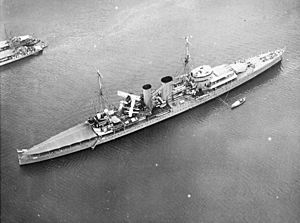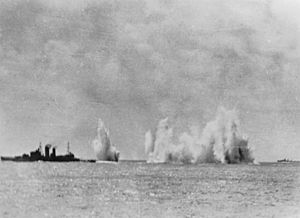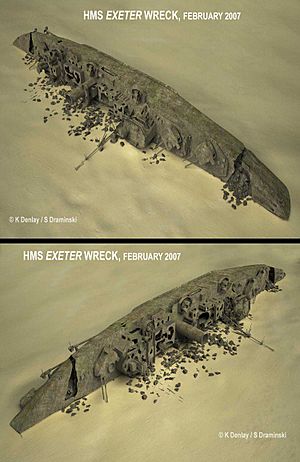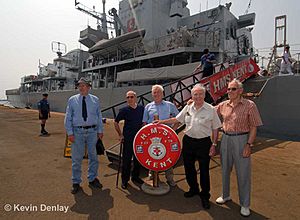HMS Exeter (68) facts for kids

Exeter underway off the coast of Coco Solo in 1939
|
|
Quick facts for kids History |
|
|---|---|
| Name | Exeter |
| Namesake | Exeter |
| Ordered | 15 March 1928 |
| Builder | Devonport Dockyard, Plymouth |
| Laid down | 1 August 1928 |
| Launched | 18 July 1929 |
| Commissioned | 27 July 1931 |
| Identification | Pennant number: 68 |
| Fate | Sunk during the Second Battle of the Java Sea, 1 March 1942, wreck destroyed by illegal salvagers 2014–2016 |
| General characteristics (as built) | |
| Class and type | York-class heavy cruiser |
| Displacement | |
| Length |
|
| Beam | 58 ft (17.7 m) |
| Draught | 20 ft 3 in (6.2 m) deep load |
| Installed power |
|
| Propulsion | 4 × shafts; 4 × geared steam turbine sets |
| Speed | 32 knots (59 km/h; 37 mph) |
| Range | 10,000 nmi (19,000 km; 12,000 mi) at 14 knots (26 km/h; 16 mph) |
| Complement | 628 |
| Armament |
|
| Armour |
|
| Aircraft carried | 2 × seaplanes |
| Aviation facilities | 2 × aircraft catapults |
HMS Exeter was a powerful warship known as a heavy cruiser. It was built for the Royal Navy in the late 1920s. For most of the 1930s, Exeter served in the Atlantic Fleet and in waters around North America and the West Indies.
When World War II started in September 1939, Exeter was sent to patrol the waters near South America. Its job was to hunt for German ships that were attacking merchant vessels. Later that year, Exeter became famous for its role in the Battle of the River Plate. It was one of three British cruisers that fought against the German heavy cruiser Admiral Graf Spee. Exeter was badly damaged in this battle and spent over a year being repaired.
After its repairs, the ship helped protect convoys (groups of ships traveling together) in 1941. Then, it was sent to the Far East when the Pacific War began in December. Exeter mostly escorted convoys to and from Singapore during the Malayan Campaign. In February 1942, it joined the American-British-Dutch-Australian Command (ABDACOM) to defend the Dutch East Indies from Japanese invasion.
Exeter fought in the Battle of the Java Sea later that month. It was damaged early in the fight and had to withdraw. Two days later, while trying to escape, it was attacked again by Japanese ships and sunk in the Second Battle of the Java Sea on March 1, 1942. Most of its crew survived the sinking but became prisoners of war. Sadly, about a quarter of them died while held by the Japanese. The wreck of Exeter was found in 2007. It was a war grave, but by 2016, illegal salvagers had destroyed its remains.
Contents
Ship Design and Features
Exeter was built two years after its sister ship HMS York. Its design included improvements based on lessons learned from York. For example, Exeter's width (called its beam) was made a bit wider. This helped balance the ship better. Its funnels (smokestacks) were also placed further back from the bridge, which is the control center of the ship. This helped keep smoke away from the bridge.
The ship was designed to carry two seaplanes. It had two aircraft catapults to launch them. These catapults were angled outwards in a "V" shape. The bridge was also designed to be lower and more streamlined than York's.
Exeter weighed about 8,390 long tons (8,520 t) when fully loaded. It was 575 feet 1 inch (175.3 m) long and 58 feet (17.7 m) wide. The ship was powered by four steam turbine engines, which got their steam from eight large boilers. These engines gave Exeter a top speed of 32 knots (59 km/h; 37 mph) (about 37 miles per hour). It could travel 10,000 nautical miles (18,520 km; 11,510 mi) (about 11,500 miles) at a slower speed of 14 knots (26 km/h; 16 mph). The ship had a crew of 628 sailors.
Weapons and Protection
The main weapons on Exeter were six large 8-inch guns. These were placed in three twin-gun turrets. Two turrets were at the front of the ship, and one was at the back. For defense against aircraft, it had four 4-inch anti-aircraft (AA) guns and two smaller 40 mm AA guns. The ship also carried two triple torpedo tubes for firing 21-inch torpedoes.
Exeter had armor to protect its important parts. The sides of its engine and boiler rooms, and its ammunition storage areas (magazines), were protected by 3 inches (76 mm) of armor. The deck over these areas had 1.5 inches (38 mm) of armor.
Ship Upgrades
Over the years, Exeter received some upgrades. In 1932, its fixed catapults for its Fairey IIIF floatplanes were installed. In 1934–1935, its smaller 40 mm AA guns were replaced with four Vickers 0.5-inch machine guns.
After the Battle of the River Plate in 1939, Exeter was heavily damaged. While it was being repaired in 1940–1941, the Royal Navy decided to give it major upgrades. The ship's bridge was rebuilt and made larger. Its single 4-inch AA guns were replaced with more powerful twin-gun mounts. Also, two new mounts for 40 mm "pom-pom" AA guns were added. The ship also received new tripod masts to hold its new early-warning radar and fire-control radar. These radars helped the ship detect enemies and aim its guns better.
Service in World War II
Exeter was the fourth ship in the Royal Navy to carry that name. It was built starting in 1928, launched in 1929, and officially joined the fleet in 1931. Before the war, it served in the Atlantic Fleet and later in the America and West Indies Station.
The Battle of the River Plate
When World War II began, Exeter was part of a group of British ships hunting German warships off South America. On December 13, 1939, Exeter and two light cruisers, HMS Ajax and HMNZS Achilles, found the German heavy cruiser Admiral Graf Spee.
The British plan was to split their forces to make it harder for the German ship to target them. Exeter attacked from one side, while Ajax and Achilles attacked from another. The Admiral Graf Spee focused its main guns on Exeter. At 6:18 AM, the German ship opened fire. Exeter fired back two minutes later. The German ship quickly hit Exeter several times. One hit knocked out a gun turret, and shrapnel (metal fragments) killed many crew members on the bridge. Captain Frederick Bell, though wounded, moved to a different control position to keep fighting.
Exeter launched torpedoes, forcing the Admiral Graf Spee to turn away. But the German ship continued to hit Exeter. More hits knocked out another gun turret and caused fires and flooding. Despite heavy damage, Exeters engines were still working. Captain Bell even considered ramming the German ship! By 7:30 AM, most of Exeters guns were out of action due to damage and flooding. Captain Bell reported that his ship could still make 18 knots (33 km/h; 21 mph) and had a few guns working. He was ordered to sail to the Falkland Islands for repairs.
Exeter was hit by seven large shells. Sixty-one of its crew were killed, and 23 were wounded. In return, Exeter hit Admiral Graf Spee three times. One hit damaged the German ship's fuel system, making it difficult for it to return to Germany. A few days later, the Admiral Graf Spee was sunk by its own captain in the harbor of Montevideo.
Exeter was badly damaged but managed to reach Port Stanley for emergency repairs. It then sailed all the way back to England for a major overhaul and modernization. This took over a year, from February 1940 to March 1941.
Journey to the Far East
After its repairs, Exeter spent some time practicing and patrolling in northern waters. On May 22, 1941, it left Britain for the last time. It escorted a convoy of ships to Aden (in Yemen) and then continued to the Far East. Exeter became part of the East Indies Squadron, which later became the Far East Fleet.
For several months, Exeter escorted convoys in the Indian Ocean and Arabian Sea. It visited places like Bombay (India) and Colombo (Sri Lanka). In December 1941, the Pacific War began. Exeter was ordered to rush to Singapore to help defend against the Japanese. It arrived on December 10, but it was too late to help the battleships HMS Repulse and HMS Prince of Wales, which had already been sunk. Exeter helped treat some of the survivors from those ships.
For the next two months, Exeter continued to escort convoys to Singapore, which eventually fell to the Japanese on February 15, 1942. During this time, Exeter joined the new American-British-Dutch-Australian Command (ABDACOM).
The Gaspar Strait Sortie
On February 13, 1942, Allied planes spotted Japanese invasion convoys. The commander of the ABDA naval forces, Vice Admiral Conrad Helfrich, ordered a group of Allied ships, including Exeter, to intercept them. This group, led by Dutch Rear Admiral Karel Doorman, sailed through the Gaspar Strait.
While in the strait, a Dutch destroyer hit a rock. Japanese planes soon spotted the Allied ships and began attacking them. Exeter was attacked by Nakajima B5N "Kate" torpedo bombers. A bomb that landed close by damaged its Walrus seaplane, but the ship itself only got minor damage from shrapnel. More Japanese bombers attacked throughout the day, but they caused little damage.
Because of the constant air attacks, Admiral Doorman decided it was too risky to continue. He ordered his ships to turn back. The Japanese attacks continued, but they were mostly ineffective.
First Battle of the Java Sea
On February 25, Admiral Helfrich ordered all available warships to join Admiral Doorman's force at Surabaya. Exeter and the Australian light cruiser HMAS Perth, along with three British destroyers, quickly sailed to join them. On February 27, Doorman's force of five cruisers and nine destroyers sailed to find the Japanese invasion convoy.
The Japanese found the Allied ships first. At 3:47 PM, Japanese heavy cruisers opened fire. Japanese light cruisers and destroyers also launched their powerful "Long Lance" torpedoes. One torpedo hit Exeter but did not explode. Three minutes later, a shell from the Japanese cruiser Haguro hit Exeter. It exploded in a boiler room, knocking out six of its boilers and killing 14 crew members. The ship slowed down to only 5 knots (9.3 km/h; 5.8 mph) (about 6 miles per hour) and had to leave the battle line.
Another torpedo from Haguro then hit and sank the Dutch destroyer HNLMS Kortenaer. HMAS Perth created a smoke screen to protect Exeter. Exeter was escorted by one Dutch and two British destroyers. The Japanese launched more torpedoes, but they all missed. One of the British destroyers, HMS Electra, was sunk while fighting two Japanese destroyers. Exeter, escorted by HMS Encounter and HNLMS Witte de With, managed to reach Surabaya harbor.
Second Battle of the Java Sea
After making temporary repairs and refueling, Exeter was ordered to sail to Colombo (Sri Lanka) via the Sunda Strait. It left on the evening of February 28, escorted by HMS Encounter and the American destroyer USS Pope.
On the morning of March 1, they were intercepted by four Japanese heavy cruisers and four destroyers. Around 8:00 AM, the British ships spotted two Japanese cruisers. By 9:30 AM, the Japanese ships opened fire. The Allied ships tried to escape by laying smoke and turning away. Exeter managed to reach 26 knots (48 km/h; 30 mph) (about 30 miles per hour) for a short time.
However, around 11:20 AM, Exeter was hit. The shell exploded in its forward boiler room, knocking out all power. Without power, its guns could not move or fire. Captain Gordon ordered the ship to be scuttled (sunk on purpose) to prevent it from being captured. Exeter began to list (tilt) to its left side. Japanese destroyers then fired torpedoes. Two torpedoes hit Exeter on its right side. The ship quickly straightened itself, paused, and then rolled over and sank to its right side. HMS Encounter and USS Pope were also lost in the battle.
The Japanese rescued 652 of Exeter's crew, including Captain Gordon. These men became prisoners of war. Sadly, 152 of them died while in Japanese captivity.
Wreck Site
The wreck of Exeter was found on February 21, 2007, by a group of divers. It was lying on its right side in Indonesian waters, about 200 feet (61 m) deep. This location was about 90 miles (140 km) northwest of Bawean Island.
In July 2008, HMS Kent held a memorial service over the wreck. Several British officials, naval officers, a BBC film crew, and four Exeter veterans who survived the sinking were present. The wreck was considered a British war grave, a protected site. However, by 2016, illegal salvagers had destroyed the remains of the wreck.







